Submitted:
10 May 2023
Posted:
12 May 2023
You are already at the latest version
Abstract
Keywords:
1. Introduction
2. Materials and Methods
3. Results
4. Conclusions
Author Contributions
Funding
Conflicts of Interest
References
- Kim, D.-Y.; Moon, S.E.; Kim, E.-K.; Lee, S.-J.; Choi, J.-J.; Kim, H.-E. Electro-Optic Characteristics of (001)-Oriented Ba0.6Sr0.4TiO3 Thin Films. Appl. Phys. Lett. 2003, 82, 1455–1457. [CrossRef]
- Mukhortov, V.M.; Masychev, S.I.; Golovko, Y.I.; Chub, A. V.; Mukhortov, V.M. Application of Nanodimensional Barium-Strontium Titanate Films in Tunable Microwave Devices. Tech. Phys. 2006, 51, 1359–1361. [CrossRef]
- Brekhov, K.A.; Lavrov, S.D. Electro-Optic Properties of Ba0.8Sr0.2TiO3 Thin Film. Ceram. Int. 2020. [CrossRef]
- Eltes, F.; Mai, C.; Caimi, D.; Kroh, M.; Popoff, Y.; Winzer, G.; Petousi, D.; Lischke, S.; Ortmann, J.E.; Czornomaz, L.; et al. A BaTiO 3 -Based Electro-Optic Pockels Modulator Monolithically Integrated on an Advanced Silicon Photonics Platform. J. Light. Technol. 2019, 37, 1456–1462. [CrossRef]
- Stanciu, C.D.; Hansteen, F.; Kimel, A. V.; Kirilyuk, A.; Tsukamoto, A.; Itoh, A.; Rasing, T. All-Optical Magnetic Recording with Circularly Polarized Light. Phys. Rev. Lett. 2007, 99. [CrossRef]
- Vahaplar, K.; Kalashnikova, A.M.; Kimel, A. V.; Gerlach, S.; Hinzke, D.; Nowak, U.; Chantrell, R.; Tsukamoto, A.; Itoh, A.; Kirilyuk, A.; et al. All-Optical Magnetization Reversal by Circularly Polarized Laser Pulses: Experiment and Multiscale Modeling. Phys. Rev. B 2012, 85, 104402. [CrossRef]
- Blank, T.G.H.; Grishunin, K.A.; Ivanov, B.A.; Mashkovich, E.A.; Afanasiev, D.; Kimel, A. V. Empowering Control of Antiferromagnets by THz-Induced Spin Coherence. 2022.
- Blank, T.G.H.; Grishunin, K.A.; Zvezdin, K.A.; Hai, N.T.; Wu, J.C.; Su, S.-H.; Huang, J.-C.A.; Zvezdin, A.K.; Kimel, A. V. Two-Dimensional THz Spectroscopy of Nonlinear Phononics in the Topological Insulator $\mathrm{MnBi}_2\mathrm{Te}_4$. 2022.
- Mashkovich, E.A.; Grishunin, K.A.; Zvezdin, A.K.; Blank, T.G.H.; Zavyalov, A.G.; van Loosdrecht, P.H.M.; Kalashnikova, A.M.; Kimel, A. V. Terahertz-Driven Magnetization Dynamics of Bismuth-Substituted Yttrium Iron-Gallium Garnet Thin Film near a Compensation Point. Phys. Rev. B 2022, 106, 184425. [CrossRef]
- Kalashnikova, A.M.; Kimel, A. V.; Pisarev, R. V.; Gridnev, V.N.; Kirilyuk, A.; Rasing, T. Impulsive Generation of Coherent Magnons by Linearly Polarized Light in the Easy-Plane Antiferromagnet FeBO3. Phys. Rev. Lett. 2007, 99, 167205. [CrossRef]
- Kalashnikova, A.M.; Kimel, A. V.; Pisarev, R. V.; Gridnev, V.N.; Usachev, P.A.; Kirilyuk, A.; Rasing, T. Impulsive Excitation of Coherent Magnons and Phonons by Subpicosecond Laser Pulses in the Weak Ferromagnet FeBO3. Phys. Rev. B 2008, 78, 104301. [CrossRef]
- Subkhangulov, R.R.; Henriques, A.B.; Rappl, P.H.O.; Abramof, E.; Rasing, T.; Kimel, A. V. All-Optical Manipulation and Probing of the d–f Exchange Interaction in EuTe. Sci. Rep. 2014, 4, 4368. [CrossRef]
- Mikhaylovskiy, R.V.; Hendry, E.; Secchi, A.; Mentink, J.H.; Eckstein, M.; Wu, A.; Pisarev, R.V.; Kruglyak, V.V.; Katsnelson, M.I.; Rasing, T.; et al. Ultrafast Optical Modification of Exchange Interactions in Iron Oxides. Nat. Commun. 2015, 6, 8190. [CrossRef]
- Yukalov, V.I.; Yukalova, E.P. Ultrafast Polarization Switching in Ferroelectrics. Phys. Rev. Res. 2019, 1, 033136. [CrossRef]
- Caputo, J.-G.; Kazantseva, E. V.; Maimistov, A.I. Electromagnetically Induced Switching of Ferroelectric Thin Films. Phys. Rev. B 2007, 75, 014113. [CrossRef]
- Chen, P.; Paillard, C.; Zhao, H.J.; Íñiguez, J.; Bellaiche, L. Deterministic Control of Ferroelectric Polarization by Ultrafast Laser Pulses. Nat. Commun. 2022, 13, 2566. [CrossRef]
- Abalmasov, V.A. Ultrafast Reversal of the Ferroelectric Polarization by a Midinfrared Pulse. Phys. Rev. B 2020, 101, 014102. [CrossRef]
- Zhilyaev, P.; Starykh, E.; Brekhov, K.; Mishina, E. Modeling of Ultrafast Polarization Switching in PbTiO3. Materialia 2023, 27, 101681. [CrossRef]
- Brekhov, K.A.; Grishunin, K.A.; Afanas’ev, D. V.; Semin, S. V.; Sherstyuk, N.E.; Kitaeva, G.K.; Mishina, E.D.; Rasing, T.; Kimel, A. V. Photoinduced Dynamics and Femtosecond Excitation of Phonon Modes in Ferroelectric Semiconductor Sn2P2S6. JETP Lett. 2015, 102, 372–377. [CrossRef]
- Brekhov, K.A.A.; Grishunin, K.A.A.; Afanas’ev, D.V. V.; Semin, S.V. V.; Sherstyuk, N.E.E.; Mishina, E.D.D.; Kimel, A.V. V. Optical Second Harmonic Generation and Its Photoinduced Dynamics in Ferroelectric Semiconductor Sn2P2S6. Phys. Solid State 2018, 60, 31–36. [CrossRef]
- Brekhov, K.A.; Ilyin, N.A.; Mishina, E.D.; Prudkovskii, P.A.; Kitaeva, G.K. The Temperature Dependence of the Photoinduced Soft Mode in Sn2P2S6 Crystal. Int. J. Mod. Phys. B 2019, 33. [CrossRef]
- Grishunin, K.A.; Ilyin, N.A.; Sherstyuk, N.E.; Mishina, E.D.; Kimel, A.; Mukhortov, V.M.; Ovchinnikov, A. V.; Chefonov, O. V.; Agranat, M.B. THz Electric Field-Induced Second Harmonic Generation in Inorganic Ferroelectric. Sci. Rep. 2017, 7, 687. [CrossRef]
- Bilyk, V.; Mishina, E.; Sherstyuk, N.; Bush, A.; Ovchinnikov, A.; Agranat, M. Transient Polarization Reversal Using an Intense THz Pulse in Silicon-Doped Lead Germanate. Phys. status solidi – Rapid Res. Lett. 2021, 15, 2000460. [CrossRef]
- Mankowsky, R.; von Hoegen, A.; Först, M.; Cavalleri, A. Ultrafast Reversal of the Ferroelectric Polarization. Phys. Rev. Lett. 2017, 118, 197601. [CrossRef]
- Grübel, S.; Johnson, J.A.; Beaud, P.; Dornes, C.; Ferrer, A.; Haborets, V.; Huber, L.; Huber, T.; Kohutych, A.; Kubacka, T.; et al. Ultrafast X-Ray Diffraction of a Ferroelectric Soft Mode Driven by Broadband Terahertz Pulses. arXiv 2016, 1–5.
- Shirokov, V.B.; Biryukov, S. V.; Mukhortov, V.M.; Yuzyuk, Y.I. Polarization of Thin Barium-Strontium Titanate Films by an External Electric Field. Tech. Phys. 2011, 56, 1175–1180. [CrossRef]
- Zinchenko, S.P.; Stryukov, D. V.; Pavlenko, A. V.; Mukhortov, V.M. The Effect of a Ba0.2Sr0.8TiO3 Sublayer on the Structure and Electric Characteristics of Lead Zirconate Titanate Films on the Si(001) Substrate. Tech. Phys. Lett. 2020, 46, 1196–1199. [CrossRef]
- García, R.; Gonzalo, J.A. Dynamic Critical Behavior of Ferroelectric Triglycine Sulfate from Dielectric Loss Measurements. Phys. Rev. Lett. 1983, 50, 1501–1504. [CrossRef]
- Vorotilov, K.A.; Sigov, A.S. Ferroelectric Memory. Phys. Solid State 2012, 54, 894–899. [CrossRef]
- Ngo, T.Q.; Posadas, A.B.; McDaniel, M.D.; Hu, C.; Bruley, J.; Yu, E.T.; Demkov, A.A.; Ekerdt, J.G. Epitaxial c -Axis Oriented BaTiO 3 Thin Films on SrTiO 3 -Buffered Si(001) by Atomic Layer Deposition. Appl. Phys. Lett. 2014, 104, 082910. [CrossRef]
- Vaithyanathan, V.; Lettieri, J.; Tian, W.; Sharan, A.; Vasudevarao, A.; Li, Y.L.; Kochhar, A.; Ma, H.; Levy, J.; Zschack, P.; et al. C-Axis Oriented Epitaxial BaTiO3 Films on (001) Si. J. Appl. Phys. 2006, 100, 024108. [CrossRef]
- Anokhin, A.S.; Biryukov, S. V.; Golovko, Y.I.; Mukhortov, V.M. Structural and Electric Characteristics of Two-Layer Bi4Ti3O12/(Ba,Sr)TiO3 Thin Films Deposited on a Silicon Substrate by Radio-Frequency Sputtering at Increased Oxygen Pressures. Phys. Solid State 2019, 61, 139–144. [CrossRef]
- Sharma, S.; Tomar, M.; Puri, N.K.; Gupta, V. Ultraviolet Radiation Detection by Barium Titanate Thin Films Grown by Sol-Gel Hydrothermal Method. Procedia Eng. 2014, 87, 1172–1175. [CrossRef]
- Pavlov, D.P.; Batalov, R.I.; Leontyev, A. V.; Zharkov, D.K.; Migachev, S.A.; Lunev, I. V.; Mukhortov, V.M.; Shaposhnikova, T.S.; Mamin, R.F. Investigation of the Barium Strontium Titanate Films on the Silicon Substrate. Ferroelectrics 2021, 575, 117–122. [CrossRef]
- Grishunin, K.; Bilyk, V.; Sherstyuk, N.; Mukhortov, V.; Ovchinnikov, A.; Chefonov, O.; Agranat, M.; Mishina, E.; Kimel, A. V. Transient Second Harmonic Generation Induced by Single Cycle THz Pulses in Ba0.8Sr0.2TiO3/MgO. Sci. Rep. 2019, 9, 697. [CrossRef]
- Zainullin, F.A.; Khusyainov, D.I.; Kozintseva, M. V.; Buryakov, A.M. Polarization Analysis of THz Radiation Using a Wire Grid Polarizer and ZnTe Crystal. Russ. Technol. J. 2022, 10, 74–84. [CrossRef]
- Sitnikov, D.S.; Romashevskiy, S.A.; Ovchinnikov, A. V; Chefonov, O. V; Savel’ev, A.B.; Agranat, M.B. Estimation of THz Field Strength by an Electro-Optic Sampling Technique Using Arbitrary Long Gating Pulses. Laser Phys. Lett. 2019, 16, 115302. [CrossRef]
- Mishina, E.D.; Sherstyuk, N.E.; Barskiy, D.R.; Sigov, A.S.; Golovko, Y.I.; Mukhorotov, V.M.; De Santo, M.; Rasing, T. Domain Orientation in Ultrathin (Ba,Sr)TiO3 Films Measured by Optical Second Harmonic Generation. J. Appl. Phys. 2003, 93, 6216–6222. [CrossRef]
- Mishina, E.D. Nonlinear Optics of Ferroelectrics: Towards Nanometers and Picoseconds. Ferroelectrics 2005, 314, 57–72. [CrossRef]
- Denev, S.A.; Lummen, T.T.A.; Barnes, E.; Kumar, A.; Gopalan, V. Probing Ferroelectrics Using Optical Second Harmonic Generation. J. Am. Ceram. Soc. 2011, 94, 2699–2727. [CrossRef]
- Mishina, E.; Bilyk, V.; Sherstyuk, N.; Sigov, A. Ferroelectric Switching by (Sub)-Picosecond Electromagnetic Pulse. Ferroelectrics 2021, 577, 1–12. [CrossRef]
- Yuzyuk, Y.I.; Zakharchenko, I.N.; Alyoshin, V.A.; Leont’ev, I.N.; Rabkin, L.M.; Mukhortov, V.M.; Simon, P. Influence of the Growth Mechanism and Thermoelastic Stresses on the Lattice Dynamics of Heteroepitaxial Films of Barium Strontium Titanate. Phys. Solid State 2007, 49, 1759–1765. [CrossRef]
- Anokhin, A.S.; Yuzyuk, Y.I.; Lyanguzov, N. V.; Razumnaya, A.G.; Stryukov, D. V.; Bunina, O.A.; Golovko, Y.I.; Shirokov, V.B.; Mukhortov, V.M.; El Marssi, M. Direct Transition from the Rhombohedral Ferroelectric to the Paraelectric Phase in a (Ba,Sr)TiO 3 Thin Film on a (111)MgO Substrate. EPL (Europhysics Lett. 2015, 112, 47001. [CrossRef]
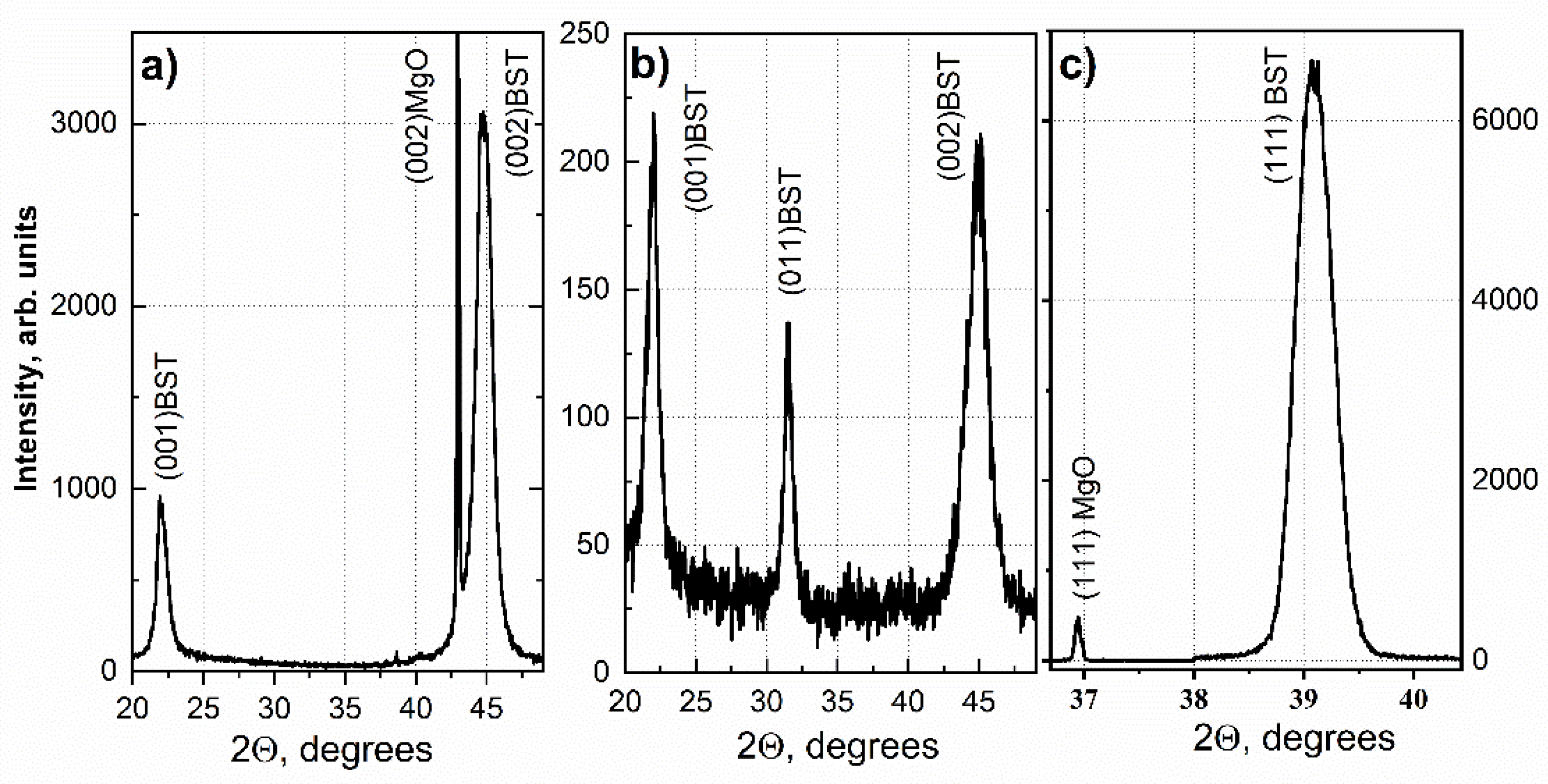
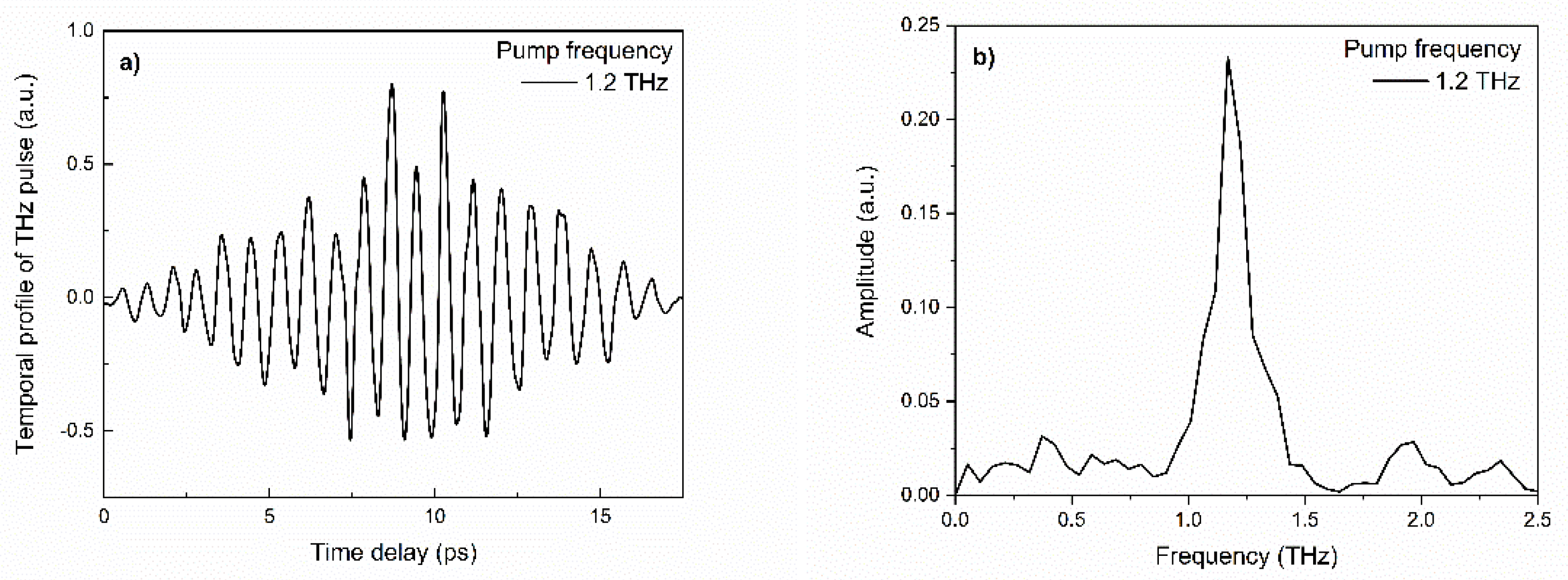
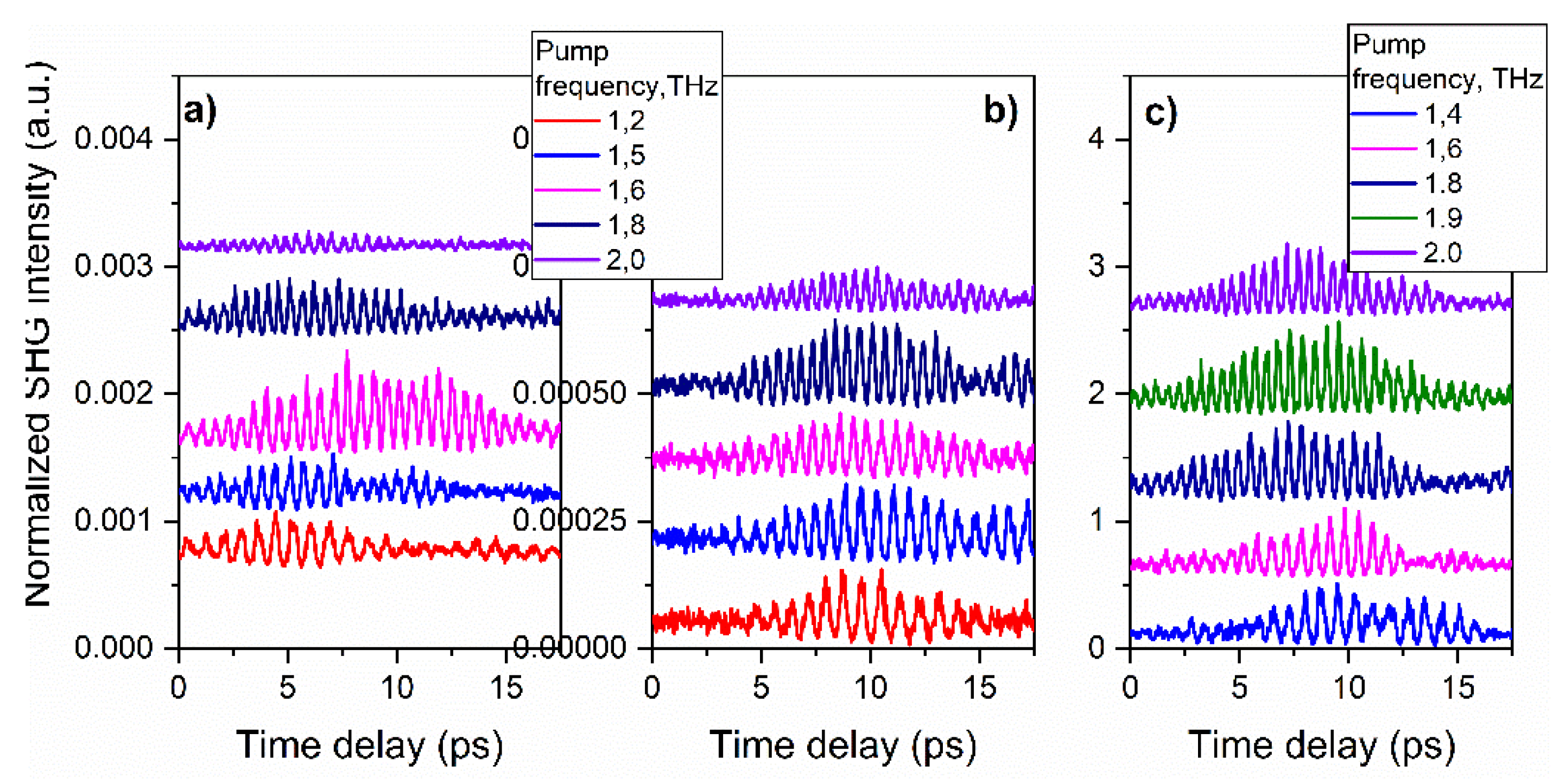
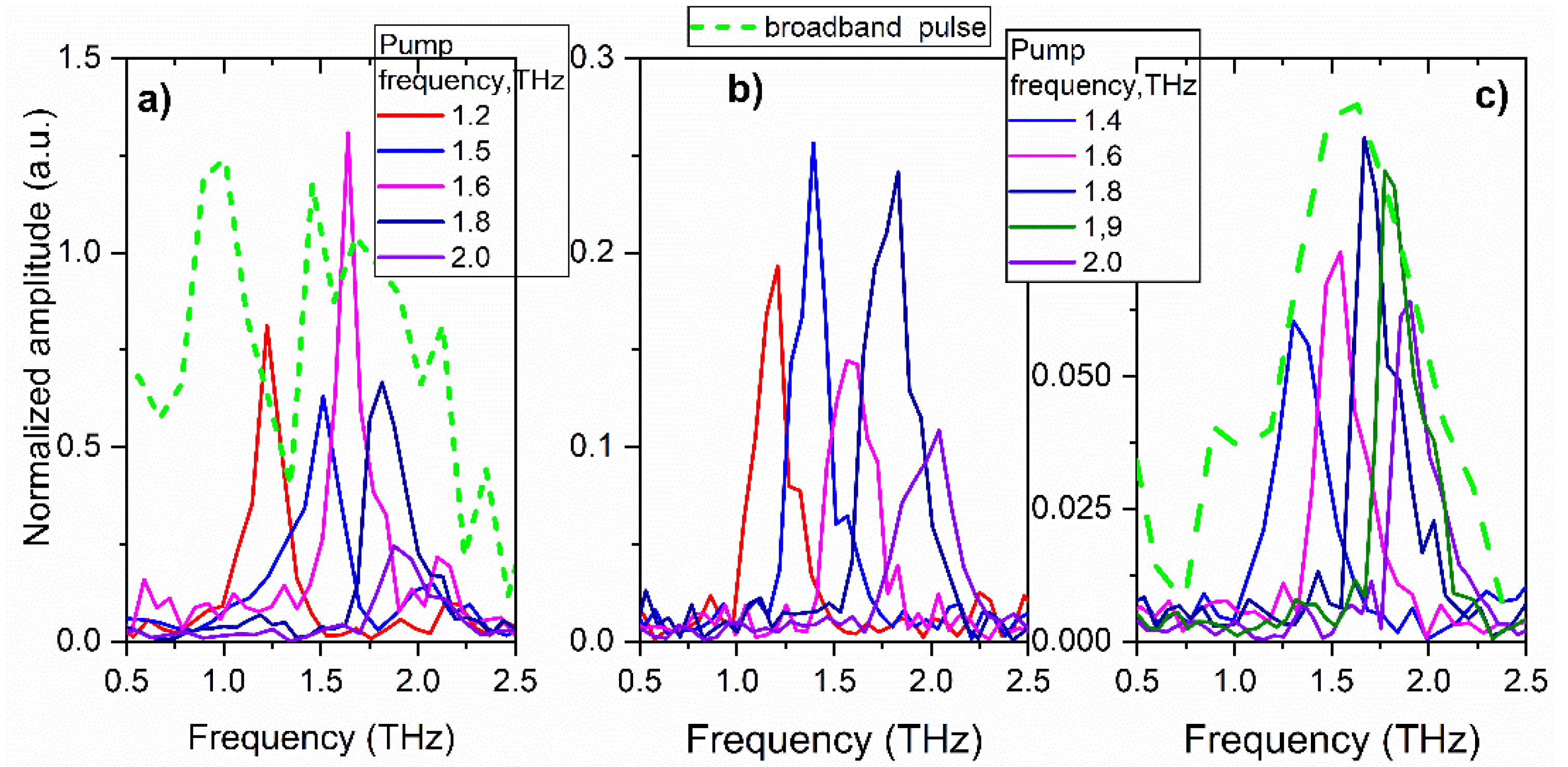
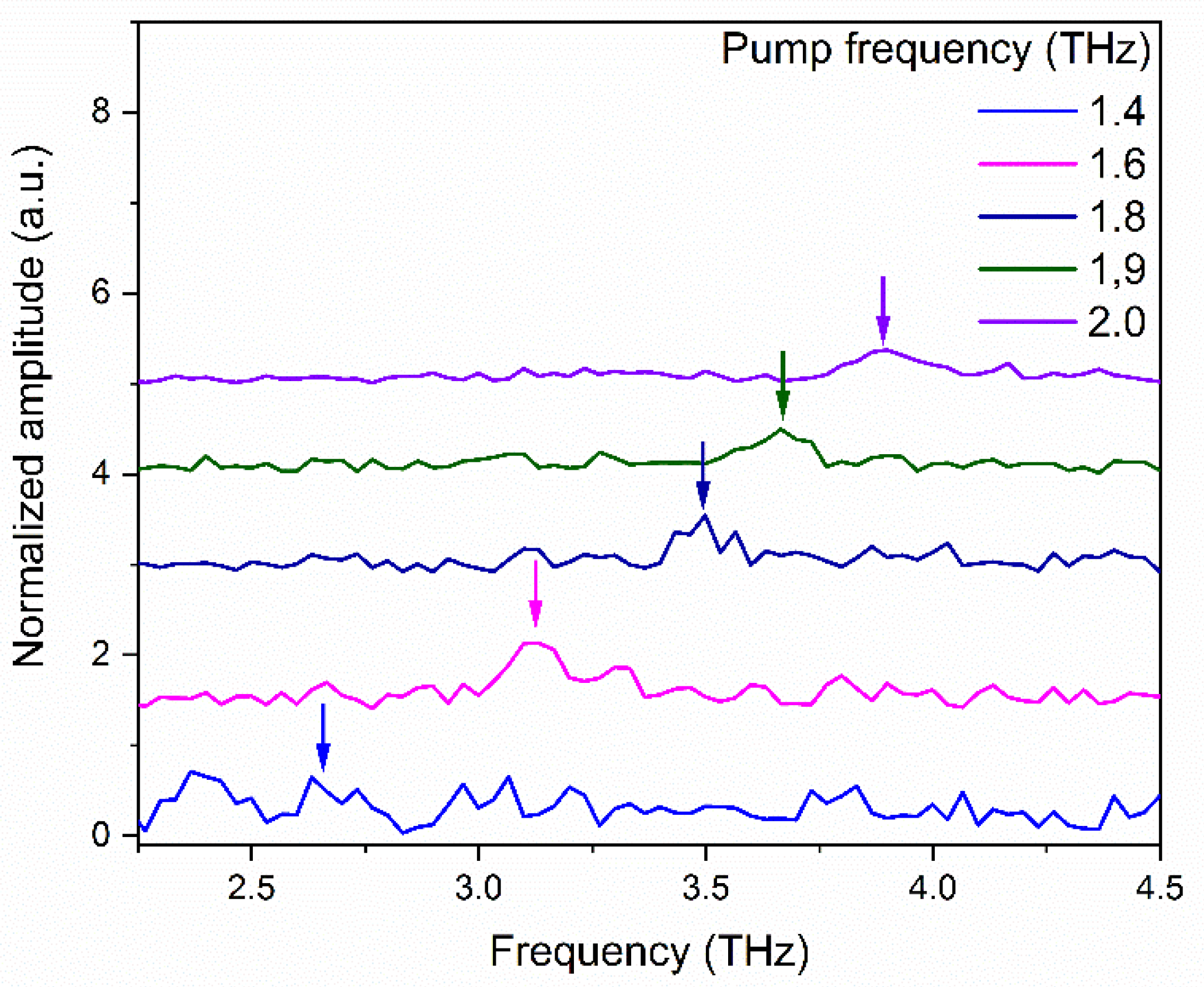
| Ba0,8Sr0,2TiO3/BREAKMgO(001) | Ba0,8Sr0,2TiO3/BREAKSi(001) | Ba0,8Sr0,2TiO3/BREAKMgO(111) | |
| Crystal structure | Single crystal | Polycrystalline | Single crystal |
| Crystallogra phic orientation | (001) | (001, 011) | (111) |
| Thickness d, nm | 375 | 375 | 800 |
| Geometry | Transmission, 0o | Reflection, 45o | Transmission, 0o |
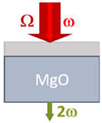 |
 |
 |
|
| Coherence length, nm | 1150 nm | 70 nm | 1150 nm |
| THz field, kV/cm | 700÷1400 | 700÷1400 | 320÷560 |
Disclaimer/Publisher’s Note: The statements, opinions and data contained in all publications are solely those of the individual author(s) and contributor(s) and not of MDPI and/or the editor(s). MDPI and/or the editor(s) disclaim responsibility for any injury to people or property resulting from any ideas, methods, instructions or products referred to in the content. |
© 2023 by the authors. Licensee MDPI, Basel, Switzerland. This article is an open access article distributed under the terms and conditions of the Creative Commons Attribution (CC BY) license (http://creativecommons.org/licenses/by/4.0/).





